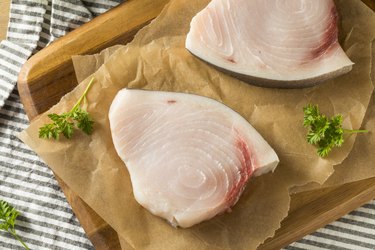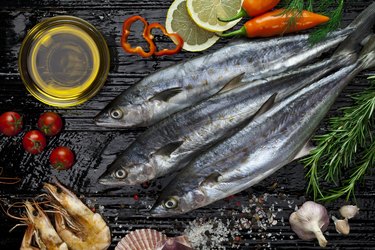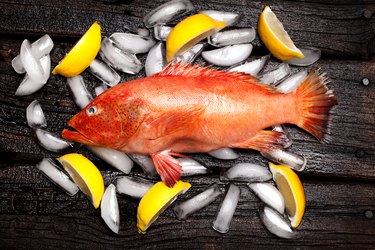
It's not just for planets in retrograde — mercury is a naturally occurring heavy metal that you want to avoid getting too much of.
Mercury is found in the Earth's crust but we can be exposed to it, often by eating fish and shellfish with high levels of a very toxic form of mercury called methylmercury in their tissues, per the United States Environmental Protection Agency (EPA).
Video of the Day
Video of the Day
Mercury is a neurotoxin and can cause loss of peripheral vision; "pins and needles" feelings; lack of coordination with movements; impairment of speech, hearing, or walking and/or muscle weakness, per the EPA.
Pregnant people need to be especially careful because mercury can harm unborn infants' growing brains and nervous systems, which may be more vulnerable to methylmercury than those of adults. It can also affect children's memory, attention, language, fine motor skills, cognitive thinking and visual-spatial skills.
So what foods contain the most mercury? Here are the types of seafood to avoid if you're watching your mercury intake — plus other sneaky offenders and healthy low-mercury alternatives.
What Is the Limit for Mercury?
The mercury limit allowed by the U.S. Food & Drug Administration (FDA) for edible fish is 1 ppm (parts per million), though the methylmercury levels for most fish are between less than 0.01 ppm and 0.5 ppm, according to Rutgers.
This amount is purposely 10 times lower than the lowest level linked to health issues such as mercury poisoning, but you should still be careful that your fish intake doesn’t add up throughout the week.
Pregnant people who eat affected species of fish may put their unborn children at risk. However, they can eat two to three servings of fish per week if it's lower in mercury, per the FDA. Check out this FDA chart to determine which fish to eat and how often based on mercury levels.
Keep in mind that pregnant and breastfeeding people, as well as children, should avoid many of the foods high in mercury below. This list is adapted from the FDA and ranks seafood according to their mean mercury concentration.
1. Tilefish: 1.123 ppm

Tilefish from the Gulf of Mexico is the highest source of mercury with a mean concentration of 1.123 ppm, per the FDA. This fish is low in fat and has a sweet flavor similar to lobster or crab, but — like other foods high in mercury — it is not recommended for women or children, per FishChoice.
2. Swordfish: 0.995 ppm
Swordfish is another high-mercury offender with 0.995 ppm, per the FDA. It's recommended that men have no more than one serving of swordfish per month (assuming no other contaminated fish is eaten), while women and children refrain from eating it, per the Environmental Defense Fund (EDF).
3. Shark: 0.979 ppm
Shark contains 0.979 ppm of mercury, per the FDA. It is not recommended for people who are pregnant or nursing or who plan to become pregnant within a year and for children younger than 6, per the Natural Resources Defense Council.
Because mercury concentration is absorbed by small organisms and works its way up the food chain, its concentration is especially high in large predatory fish like sharks.
Is There Mercury in Vegetables or Chicken?
Contamination can occur in vegetables, grains and soils from areas that surround coal-fired power plants, per a May 2017 study in Scientific Reports. If local residents of these areas source all of their vegetables and grains from their own farmland, they may encounter health risks.
Similarly, there's mercury in chickens around gold mines where mercury is used to extract gold from sediment, per Duke University. After this process, mercury is disposed of into the landscape, where it can be taken up by bacteria and plants — and eventually, it builds up in organisms like chicken. Those chickens’ eggs have mercury, too.
4. King Mackerel: 0.73 ppm

King mackerel has 0.73 ppm of mercury, per the FDA.
However, if you keep your intake in moderation (and aren't pregnant, nursing or trying to become pregnant), U.S. wild-caught king mackerel can be a smart choice for your seafood because it is sustainably managed and harvested under national regulations, per the National Oceanic and Atmospheric Administration.
5. Bigeye Tuna: 0.689 ppm
Bigeye tuna contains 0.689 ppm of mercury, per the FDA. But that's not the only reason to avoid it: This tuna has a vulnerable status due to overfishing in Eastern and Western Pacific Oceans, per the World Wildlife Fund (WWF). Plus, juvenile bigeye tuna are caught as bycatch in skipjack tuna fisheries because they school together.
A better option is to opt for canned light tuna, which has only 0.126 ppm of mercury.
6. Orange Roughy: 0.571 ppm
Orange roughy has 0.571 ppm of mercury, per the FDA. It's also not a great eco-friendly pick for your seafood: Orange roughy live extremely long lives (up to 149 years) and mature very slowly, so intensive exploitation has significantly decreased populations, per the EDF.
When it comes to mercury consumption alone, it's recommended that adults limit intake to two servings per month, assuming no other contaminated fish is eaten.
People who are pregnant, may become pregnant or nursing, and young children should avoid orange roughy, per the FDA.
7. Marlin: 0.485 ppm
Marlin contains 0.485 ppm of mercury, per the FDA. Its eco-rating can range from "OK" (blue marlin) to "worst" (imported blue marlin or striped marlin), according to the EDF.
Marlin often end up as bycatch of tuna and swordfish longline fisheries, even though they're rarely targeted by commercial fishers.
Although there's been limited research on marlin populations, most experts believe that all marlin species are in decline from heavy fishing and poor management worldwide, per the EDF. People who are pregnant, may become pregnant or nursing and young children should avoid marlin, per the FDA.
Mercury in Food vs. Vaccines
Since the 1930s, the mercury-containing organic compound thimerosal has been used as an important preservative in drugs like vaccines — helping to prevent potentially life-threatening contamination, per the FDA. It’s about 50 percent mercury by weight and is metabolized to thiosalicylate and ethylmercury, which is different from methylmercury, the substance of concern in seafood.
A vaccine that has 0.01% thimerosal as a preservative has roughly the same amount of elementary mercury you’d find in a 3-ounce can of tuna fish. Although a large body of research shows that thimerosal-containing vaccines are safe, their use has dramatically declined with the development of single-dose vaccine packaging that does not require preservatives.
8. Grouper: 0.448 ppm

Grouper fish have 0.448 ppm of mercury, per the FDA. If you're eating grouper, stick to two servings or fewer per month; kids should eat only one serving per month, per the EDF.
Grouper fisheries have been depleted in many parts of the world, though red and black grouper from the U.S. Gulf of Mexico are no longer overfished.
9. Chilean Sea Bass: 0.354 ppm
Chilean sea bass contains 0.354 ppm of mercury, per the FDA. Chilean sea bass is the market name for two species of toothfish that inhabit the cold waters of the Atlantic, Pacific and Indian Ocean near Antarctica, according to the EDF.
Although they're slow-growing and therefore prone to overfishing, they currently have an "OK" eco-rating. Look for the Marine Stewardship Council (MSC) blue eco-label for certified sustainable Chilean sea bass.
10. Halibut: 0.241 ppm
Halibut has 0.241 ppm of mercury, per the FDA. Some types of halibut tend to be higher in mercury than others. For instance, California halibut has an "elevated" mercury status while Pacific halibut (Alaska and Canada) and Greenland turbot have a "moderate" mercury status, according to the EDF.
Adults can have four or more servings of Atlantic and Pacific halibut and Greenland turbot per month, while kids ages 6 to 12 should be limited to three servings and kids age 5 or younger should be limited to two servings per month — assuming no other contaminated fish is eaten.
On the other hand, adults should limit California halibut to three servings per month, while kids ages 6 to 12 should be limited to two servings per month and kids age 5 and under should be limited to one serving per month.
Tip
Salmon, tilapia and shrimp are not high in mercury and are therefore better options if you eat seafood regularly. Salmon has 0.022 ppm of mercury, tilapia has 0.013 ppm of mercury and shrimp has 0.009 ppm of mercury.
Is High-Fructose Corn Syrup High in Mercury?
High-fructose corn syrup (HFCS) is a common additive used to enhance the shelf life of foods. It is often made with “mercury-grade” caustic soda. When caustic soda is created by a mercury cell process, it’s contaminated with 0.2 to 0.3 ppm of mercury and as much as 1 ppm in some cases, per a 2009 report from the Institute for Agriculture and Trade Policy. Limiting HFCS is also a good way to make sure you don't overeat added sugar.
Other common food ingredients made from mercury cell ingredients include citric acid and sodium benzoate, according to a January 2009 editorial in Environmental Science.
- United States Environmental Protection Agency: "Basic Information about Mercury"
- United States Environmental Protection Agency: "Health Effects of Exposures to Mercury"
- EcoWatch: "Mercury in Seafood: How Much Is Too Much?"
- Mercury Policy Project: "The Safe or 'Reference' Dose"
- U.S. Food & Drug Administration: "Mercury Levels in Commercial Fish and Shellfish (1990-2012)"
- FishChoice: "Golden Tilefish"
- Environmental Defense Fund: "Swordfish"
- UCI Health: "A zesty take on swordfish"
- Natural Resources Defense Council: "Mercury Guide"
- Scientific Reports: "Mercury pollution in vegetables, grains and soils from areas surrounding coal-fired power plants"
- Duke University: "Mercury Accumulation in Foodstuffs From Artisanal Goldmining Areas of Madre de Dios, Peru"
- National Oceanic and Atmospheric Administration: "King Mackerel"
- World Wildlife Fund: "Bigeye Tuna"
- World Wildlife Fund: "Albacore Tuna"
- Environmental Defense Fund: "Orange Roughy"
- Environmental Defense Fund: "Marlin"
- U.S. Food & Drug Administration: "Thimerosal and Vaccines"
- Environmental Defense Fund: "Grouper"
- Environmental Defense Fund: "Chilean Sea Bass"
- Environmental Defense Fund: "Halibut"
- Institute for Agriculture and Trade Policy: "Not So Sweet: Missing Mercury and High Fructose Corn Syrup"
- U.S. Food & Drug Administration: "Questions & Answers from the FDA/EPA Advice about Eating Fish for Women Who Are or Might Become Pregnant, Breastfeeding Mothers, and Young Children"
- Rutgers: "Eating Fish is Healthy: Keeping Environmental and Health Concerns in Perspective"
- Environmental Science: "Mercury from chlor-alkali plants: measured concentrations in food product sugar"